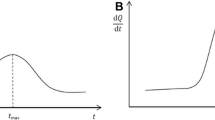Abstract
The validity of the classical additivity rule for the non-isothermal KJMA kinetics is studied. In the case of linear temperature variation, it is demonstrated that, with an exception for the isokinetic range, the kinetics is not additive. Yet, a generalized form of the additivity rule holds true with a weighting function, W, which depends upon actual temperature, heating rate, and time. The exact expression of the weighting function is computed, in closed form, for integer and half-integer Avrami exponents. The behavior of W strongly depends on the ratio between activation energies for nucleation and growth. Its effect on the rate of the transformation, as well as on transformed volume fraction, is investigated in connection with the classical additivity rule. The present results are also discussed in relation to approximate computations previously proposed in the literature.







Similar content being viewed by others
Notes
In this context we refer to the definition given by Avrami in Ref. [11]. Accordingly, in the isokinetic range the ratio between the rate of linear growth and the probability for nucleation (respectively G and n, at \( \nu = 1 \), in [11]) is independent of temperature. For \( nt < < 1 \) (during the whole transformation) the nucleation rate equals n. If n and G are energy activated, as considered here, \( \tfrac{G}{n} \) is independent of temperature provided the activation energies are equal.
References
Scheil E (1935) Anlaufzeit der austenitumwandlung. Archiv. für das Eisenhüttenwesen 8:565–567
Cahn JW (1956) Transformation kinetics during continuous cooling. Acta Metall 4:572–575
Mittemeijer EJ (1992) Analysis of the kinetics of phase transformations. J Mater Sci 27:3977–3987
Starink MJ (2004) Analysis of aluminium based alloys by calorimetry: quantitative analysis of reactions and reactions kinetics. Int Mater Rev 49:191–226
Liu F, Sommer F, Bos C, Mittemeijer EJ (2007) Analysis of solid state phase transformation kinetics: models and recipes. Int Mater Rev 52:193–212
Réti T, Felde I (1999) A non-linear extension of the addditivity rule. Comp Mater Sci 15:466–482
Rios PR (2005) Relationship between non-isothermal transformations curves and isothermal and non-isothermal kinetics. Acta Mater 53:4893–4901
Henderson DW (1979) Thermal analysis of non-isothermal crystallization kinetics in glass forming liquids. J Non-Cryst Solids 30:301–315
Song SJ, Liu F, Jiang YH (2013) Generalized additivity rule for isokinetics in diffusion-controlled growth. J Mater Sci 24:7964–7967
Kolmogorov N (1937) On the statistical theory of metal crystallization. Bull Acad Sci URSS (Cl Sci Math Nat) 3:355–359
Avrami M (1939) Kinetics of phase change I. General theory. J Chem Phys.7: 1103–1112; ibid. (1940) Kinetics of phase change II transformation-time relations for random distribution of nuclei. J Chem Phys 8:212–224; ibid. (1941) Granulation, phase change, and microstructure. Kinetics of phase change III. J. Chem Phys 9:177–184
Johnson WA, Mehl RF (1939) Reaction kinetics in processes of nucleation and growth. Trans Am Inst Min (Metall) Eng 135:416–458
Fanfoni M, Tomellini M (1998) The Johnson Mehl Avrami Kolmogorov model: a brief review. Il nuovo Cimento 20:1171–1182
Vázquez J, Wagner C, Villares P, Jimenez-Garay R (1996) A theoretical method for determining the crystallized fraction and kinetic parameters by DSC, using non-isothermal techniques. Acta Mater 44:4807–4813
Blázquez JS, Borrego JM, Conde CF, Conde A, Lozano-Pérez S (2012) Extension of the classical theory of crystallization to non-isothermal regimes: application to nanocrystallization process. J Alloys Comp 544:73–81
Malek J, Mitsuhashi T (2000) Testing Method for the Johnson-Mehl-Avrami equation in kinetic analysis of crystallization process. J Am Ceram Soc 83:2103–2105
Rheingans B, Mittemeijer EJ (2013) Phase transformation kinetics: advanced modeling strategies. JOM 65:1145–1154
Woldt E (1992) The relationship between isothermal and non-isothermal description of Johnson-Mehl-Avrami-Kolmogorov kinetics. J Phys Chem Solids 53:521–527
Ruitemberg G, Woldt E, Petford-Long AK (2001) Comparing the Johnson-Mehl-Avrami-Kolmogorov equations for isothermal and linear heating conditions. Thermochim Acta 378:97–105
Farjas J, Roura P (2006) Modification of the Kolmogorov-Johnson- Mehl-Avrami rate equation for non-isothermal experiments and its analytical solution. Acta Mater 54:5573–5579
Vázquez J, García- Barreda D, López-Alemany PL, Villares P, Jiménez-Gary R (2006) A study on non-isothermal transformation kinetics application to the crystallization of the Ge0.18Sb0.23Se0.59 glassy alloy. Mater Chem Phys 96:107–115
Tomellini M (2013) Functional form of the Kolmogorov-Johnson-Mehl-Avrami kinetics for non-isothermal phase transformations at constant heating rate. Thermochim Acta 566:249–256
Tomellini M (2014) Kolmogorov-Johnson- Mehl-Avrami kinetics for non-isothermal phase transformations ruled by diffusional growth. J Therm Anal Calorim 116:853–864
Schepilov MP (2005) On calculation of the transformation kinetics for models with diffusional law of growth of new-phase precipitates. Cryst Rep 50:513–516
Alekseechkin NV (2011) Extension of the Kolmogorov-Johnson- Mehl-Avrami theory to growth law of diffusion type. J Non Cryst Solids 357:3159–3167
Author information
Authors and Affiliations
Corresponding author
Appendices
Appendix 1
By differentiating \( \eta = \frac{{S_{m - 1} }}{{S_{m}^{m/m + 1} }} \), one gets
Use of Eq. 9a in Eq.18 gives (\( m \ne 1 \)),
or
Since \( W = \eta /\eta_{i} = \eta e^{{\frac{{(a - b)}{\tau }}{{(m + 1)}{(1 + \tau) }}}} \), with \( \eta_{i} (T_{0} ,\tau ) = e^{{ - \frac{{(a - b)}{\tau }}{{(m + 1)}{(1 + \tau )}}}} \), the integration of Eq. 19 leads to
Appendix 2
At temperature T, the isothermal kinetics is
The time \( t_{F} (T) \) needed to complete about 95 % of the transformation at T (i.e., \( X(t_{F} ) = 1 - e^{ - 3} \)) is equal to \( t_{F} (T) = \frac{{[3(1 + m)]^{1/(m + 1)} }}{{Ae^{{ - {\left(\frac{ma + b}{m + 1}\right)}\frac{{T_{0} }}{T}}} }} \), from which
In order to estimate A, in Eq. 21 we set \( T = T_{0} \) and \( t_{F} \approx 6000{\text{ s}} \).
Rights and permissions
About this article
Cite this article
Tomellini, M. Generalized additivity rule for the Kolmogorov–Johnson–Mehl–Avrami kinetics. J Mater Sci 50, 4516–4525 (2015). https://doi.org/10.1007/s10853-015-9001-5
Received:
Accepted:
Published:
Issue Date:
DOI: https://doi.org/10.1007/s10853-015-9001-5




